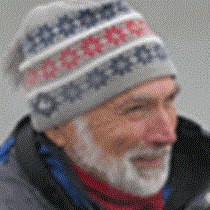Glacier Bay National Park
Although once every week the National Geographic Sea Lion’s day begins and ends in Bartlett Cove, the time in the park is never the same. It seems like many of these beginnings start with wet decks, mountains shrouded in mist and heavy overcast. Then the adventure starts as we cruise into warmer weather and sunnier skies. A humpback whale made a surface lunge shortly after we left the cove. Glassy water made viewing easy.
We visited Marble Island and all its inhabitants soon after breakfast. The deep-throated growls of hundreds of northern sea lions were punctuated with the calls of black-legged kittiwakes. A very young sea lion pup slept soundly near its mom. Pigeon guillemots and common murres looked out from the cliffs as tufted puffins flew over the ship and thrilled even the non-birdwatchers. Harlequin ducks foraged close to the rocky islands as we passed on toward brighter skies.
We turned into Tidal Inlet, a short arm that connects with the bay. It was a bonanza of bruins. We first encountered a black bear that walked across the braided stream that spills into the inlet from the north. Moments later a lone brown bear appeared. Black bears are normally found south of Tidal Inlet. The area to the north has been more recently glaciated and is the best habitat for browns, while the land to the south has more forest and is better suited for black bears. As the forests march northward in Glacier Bay the black bears do too, but perhaps to a different drummer.
Just around the corner, and after viewing several mountain goat nannies with kids, we found another brownie scraping and turning over intertidal rocks. Later in the morning two more brownies walked out of the trees together, bumped each other a few times, then stood on their back legs and pushed at one another. Bears are together only because of a common food source, a sow with cubs, siblings from the past year or when courting. These two were certainly bigger than cubs. A bit farther, another brown bear walked along the forest margin. This was the one in today’s photograph. The grasses and sedges are accentuated by paintbrush flowers. Patches of blue sky appeared overhead.
As we drew closer to the glaciers, the landscape looked more barren of trees and shrubs. As we neared Margerie Glacier there was a lot of ice floating about, an indication of recent calving. The largest splashes were when we first arrived. Many more followed as we watched kittiwakes fly back and forth to their nesting cliffs just south of Margerie’s lateral moraine. Time soon ran out, and we turned south and stopped briefly at Lamplugh Glacier. Next we entered Geikie Inlet and then on to Bartlett Cove. After dinner, hikers of all speeds quickly spread out from the dock and later coalesced at the lodge as evening fell around us.
Although once every week the National Geographic Sea Lion’s day begins and ends in Bartlett Cove, the time in the park is never the same. It seems like many of these beginnings start with wet decks, mountains shrouded in mist and heavy overcast. Then the adventure starts as we cruise into warmer weather and sunnier skies. A humpback whale made a surface lunge shortly after we left the cove. Glassy water made viewing easy.
We visited Marble Island and all its inhabitants soon after breakfast. The deep-throated growls of hundreds of northern sea lions were punctuated with the calls of black-legged kittiwakes. A very young sea lion pup slept soundly near its mom. Pigeon guillemots and common murres looked out from the cliffs as tufted puffins flew over the ship and thrilled even the non-birdwatchers. Harlequin ducks foraged close to the rocky islands as we passed on toward brighter skies.
We turned into Tidal Inlet, a short arm that connects with the bay. It was a bonanza of bruins. We first encountered a black bear that walked across the braided stream that spills into the inlet from the north. Moments later a lone brown bear appeared. Black bears are normally found south of Tidal Inlet. The area to the north has been more recently glaciated and is the best habitat for browns, while the land to the south has more forest and is better suited for black bears. As the forests march northward in Glacier Bay the black bears do too, but perhaps to a different drummer.
Just around the corner, and after viewing several mountain goat nannies with kids, we found another brownie scraping and turning over intertidal rocks. Later in the morning two more brownies walked out of the trees together, bumped each other a few times, then stood on their back legs and pushed at one another. Bears are together only because of a common food source, a sow with cubs, siblings from the past year or when courting. These two were certainly bigger than cubs. A bit farther, another brown bear walked along the forest margin. This was the one in today’s photograph. The grasses and sedges are accentuated by paintbrush flowers. Patches of blue sky appeared overhead.
As we drew closer to the glaciers, the landscape looked more barren of trees and shrubs. As we neared Margerie Glacier there was a lot of ice floating about, an indication of recent calving. The largest splashes were when we first arrived. Many more followed as we watched kittiwakes fly back and forth to their nesting cliffs just south of Margerie’s lateral moraine. Time soon ran out, and we turned south and stopped briefly at Lamplugh Glacier. Next we entered Geikie Inlet and then on to Bartlett Cove. After dinner, hikers of all speeds quickly spread out from the dock and later coalesced at the lodge as evening fell around us.




